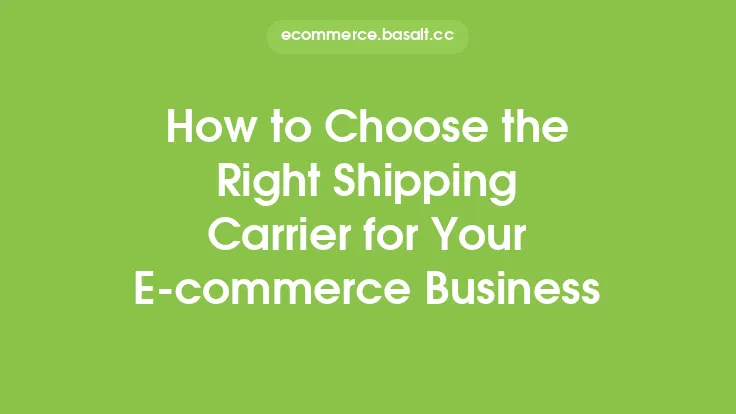The e-commerce industry has experienced tremendous growth over the past decade, and shipping has become a critical component of the online shopping experience. As consumers, we expect fast, reliable, and affordable shipping options, and companies that fail to deliver on these expectations risk losing customers and revenue. In this article, we'll explore the current state of e-commerce shipping, including the trends, challenges, and best practices that businesses need to know to stay competitive.
Introduction to E-commerce Shipping
E-commerce shipping refers to the process of transporting products from a seller's warehouse or fulfillment center to the customer's doorstep. It involves a range of activities, including packaging, labeling, and shipping, as well as tracking and delivery confirmation. With the rise of e-commerce, shipping has become a critical component of the online shopping experience, and companies that fail to deliver on their shipping promises risk losing customers and revenue.
Current State of E-commerce Shipping
The current state of e-commerce shipping is characterized by increasing demand for fast and free shipping. According to a survey by the National Retail Federation, 75% of online shoppers expect free shipping on orders over $50, and 60% expect free shipping on all orders. Additionally, 50% of online shoppers expect same-day or next-day shipping, and 40% expect to be able to track their packages in real-time. To meet these expectations, companies are investing in a range of shipping technologies, including shipping software, logistics platforms, and transportation management systems.
Shipping Trends
There are several trends shaping the e-commerce shipping landscape, including the rise of omnichannel retailing, the growth of international e-commerce, and the increasing demand for sustainable shipping practices. Omnichannel retailing refers to the practice of providing a seamless shopping experience across multiple channels, including online, mobile, and physical stores. This requires companies to have a unified view of their inventory and shipping operations, and to be able to ship products from multiple locations. International e-commerce is also on the rise, with companies looking to expand their reach into new markets and territories. This requires companies to have a deep understanding of international shipping regulations and logistics.
Challenges in E-commerce Shipping
Despite the many advances in shipping technology, there are still several challenges that companies face in the e-commerce shipping space. These include the high cost of shipping, the complexity of international shipping regulations, and the difficulty of providing fast and reliable shipping options. Additionally, companies must also contend with the risk of shipping damage, loss, and theft, as well as the challenge of providing excellent customer service and support.
Best Practices for E-commerce Shipping
To overcome these challenges and provide excellent shipping experiences, companies should follow several best practices. These include investing in shipping software and logistics platforms, providing clear and transparent shipping information to customers, and offering a range of shipping options to meet different customer needs. Companies should also focus on building strong relationships with their shipping carriers and logistics providers, and on continuously monitoring and improving their shipping operations.
The Role of Technology in E-commerce Shipping
Technology plays a critical role in e-commerce shipping, enabling companies to streamline their shipping operations, reduce costs, and improve customer satisfaction. Shipping software and logistics platforms provide companies with a unified view of their shipping operations, and enable them to automate many shipping tasks, such as labeling and tracking. Additionally, technologies like artificial intelligence and machine learning are being used to optimize shipping routes and schedules, and to predict and prevent shipping disruptions.
The Importance of Shipping Strategy
A well-planned shipping strategy is critical to the success of any e-commerce company. This involves understanding the company's shipping needs and goals, and developing a plan to meet those needs. It also involves selecting the right shipping carriers and logistics providers, and negotiating the best possible rates and terms. Additionally, companies should continuously monitor and evaluate their shipping operations, and make adjustments as needed to ensure that they are providing the best possible shipping experiences for their customers.
Conclusion
In conclusion, e-commerce shipping is a complex and rapidly evolving field, with many trends, challenges, and best practices that companies need to be aware of. By understanding the current state of e-commerce shipping, and by following best practices and investing in the right technologies, companies can provide excellent shipping experiences for their customers, and stay competitive in a rapidly changing market. Whether you're a small startup or a large enterprise, a well-planned shipping strategy is critical to the success of your e-commerce business, and can help you to build customer loyalty, drive revenue growth, and achieve long-term success.





